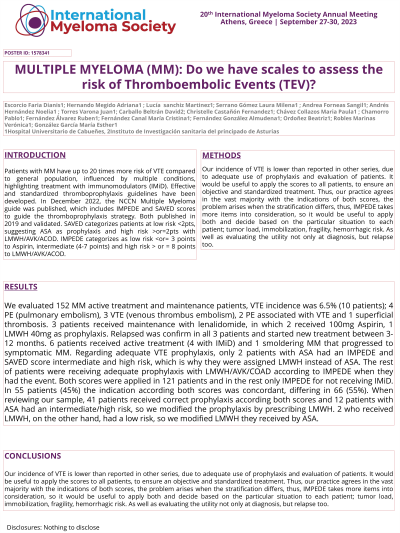QoL and Patient-Reported Outcome and Supportive Care
Poster Session 2
P-500: MULTIPLE MYELOMA: Do we have scales to assess the risk of Thromboembolic Events (TEV)?
Thursday, September 28, 2023
12:30 PM - 1:30 PM EEST

- DE
Dianis Escorcio Faria, MD (she/her/hers)
MIR
Hospital de Cabueñes
Gijon, Asturias, Spain
Introduction: Patients with MM have up to 20 times risk of VTE compared to the general population. This risk is influenced by treatment with immunomodulators (IMiD). In Dec 2022, NCCN Multiple Myeloma guide was published. It includes IMPEDE and SAVED scores to establish the thromboprophylaxis strategy. Both scores were published in 2019 and validated. SAVED categorizes patients at low risk < 2pts, suggesting ASA as prophylaxis, high risk >=2pts requiring treatment with LMWH/AVK/ACOD. IMPEDE categorizes as low risk <= 8 pts suggesting LMWH/AVK/ACOD
Methods: Retrospective descriptive study. Determine the incidence of VTE, context and adequate use of thrombus prophylaxis in our study population. We chose MM patients in active treatment and/or those being follow-up over the last 5 years 2018-2022. SAVED and IMPEDE scales were applied retrospectively at diagnosis and systematically and then we compared the results with the prophylaxis that had actually been followed. The main objective was to evaluate the incidence of VTE and to compare the score’s thromboprophylaxis guidelines to our actual practice
Results: We evaluated 152 MM active treatment and maintenance patients. VTE incidence was 6.5%, 10 patients; 4 PE (pulmonary embolism), 3 VTE, 2 PE associated with VTE and 1 superficial thrombosis. 3 patients received maintenance with lenalidomide, in which 2 received 100mg Aspirin, 1 LMWH 40mg as prophylaxis. Relapses were confirmed in all 3 patients and started new treatment between 3-12 months. 6 patients received active treatment (4 with IMiD) and 1 smoldering MM that progressed to symptomatic MM. Regarding adequate VTE prophylaxis, only 2 patients with ASA had an IMPEDE and SAVED score intermediate and high risk, which is why they were assigned LMWH instead of ASA. The rest of patients were receiving adequate prophylaxis with LMWH/AVK/COAD according to IMPEDE when they had the event. Both scores were applied in 121 patients and, for the rest, only IMPEDE for not receiving IMiD. In 55 patients 45% the indication according to both scores was concordant, differing in 66, 55%
41 patients received correct prophylaxis according to both scores and 12 patients with ASA had an intermediate/high risk, so we modified the prophylaxis by prescribing LMWH. 2 who received LMWH, had a low risk, so we modified LMWH to ASA
Conclusions: Our incidence of VTE is lower than the ones reported in other series due to adequate use of prophylaxis. It would be useful to apply the scores to all patients, to ensure an objective and standardized treatment. Thus, our practice agrees in the vast majority with the indications of both scores. The problem arises when the stratification differs, that could be explained by the fact that IMPEDE takes more items into consideration. So, it would be useful to apply both and decide based on the particular situation to each patient: tumor load, immobilization, fragility, hemorrhagic risk; as well as using them in the event of a relapse and not only at the diagnosis
Methods: Retrospective descriptive study. Determine the incidence of VTE, context and adequate use of thrombus prophylaxis in our study population. We chose MM patients in active treatment and/or those being follow-up over the last 5 years 2018-2022. SAVED and IMPEDE scales were applied retrospectively at diagnosis and systematically and then we compared the results with the prophylaxis that had actually been followed. The main objective was to evaluate the incidence of VTE and to compare the score’s thromboprophylaxis guidelines to our actual practice
Results: We evaluated 152 MM active treatment and maintenance patients. VTE incidence was 6.5%, 10 patients; 4 PE (pulmonary embolism), 3 VTE, 2 PE associated with VTE and 1 superficial thrombosis. 3 patients received maintenance with lenalidomide, in which 2 received 100mg Aspirin, 1 LMWH 40mg as prophylaxis. Relapses were confirmed in all 3 patients and started new treatment between 3-12 months. 6 patients received active treatment (4 with IMiD) and 1 smoldering MM that progressed to symptomatic MM. Regarding adequate VTE prophylaxis, only 2 patients with ASA had an IMPEDE and SAVED score intermediate and high risk, which is why they were assigned LMWH instead of ASA. The rest of patients were receiving adequate prophylaxis with LMWH/AVK/COAD according to IMPEDE when they had the event. Both scores were applied in 121 patients and, for the rest, only IMPEDE for not receiving IMiD. In 55 patients 45% the indication according to both scores was concordant, differing in 66, 55%
41 patients received correct prophylaxis according to both scores and 12 patients with ASA had an intermediate/high risk, so we modified the prophylaxis by prescribing LMWH. 2 who received LMWH, had a low risk, so we modified LMWH to ASA
Conclusions: Our incidence of VTE is lower than the ones reported in other series due to adequate use of prophylaxis. It would be useful to apply the scores to all patients, to ensure an objective and standardized treatment. Thus, our practice agrees in the vast majority with the indications of both scores. The problem arises when the stratification differs, that could be explained by the fact that IMPEDE takes more items into consideration. So, it would be useful to apply both and decide based on the particular situation to each patient: tumor load, immobilization, fragility, hemorrhagic risk; as well as using them in the event of a relapse and not only at the diagnosis
